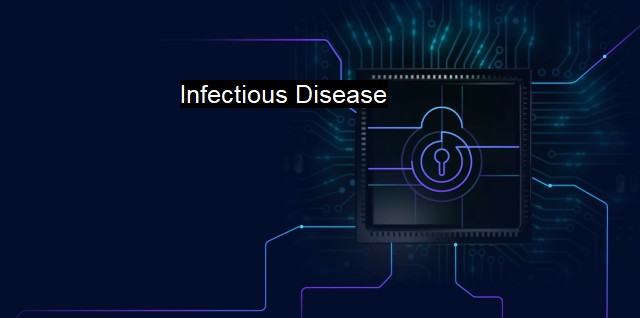What is Infectious Disease?
The Rising Threat of Infectious Diseases in the Modern Age: From Contagious Diseases to Cybersecurity
"Infectious Disease" is a term analogous to that of performing the same function as it would within medical science-related terminologies, but in digital governance and encryption circles. It manifests itself as a malicious script or mechanism that seizes control of computer systems, eroding data, draining system resources or opening up back-channels whereby data can be intercepted illegitimately and compromised by nefarious operators, disrupting the very nature of system integrity.This depiction of "Infectious Disease" acts as the perfect parallel with the biological eponym because of the extensive damage these malevolent forces can inflict within a cyber ecology, spreading like wildfire from one vulnerable point to another, bent on causing harm. The purpose of malicious code is multifold. Infectious diseases in the realm of cybersecurity can lead to asset theft, loss of critical and sensitive information, violation of privacy, causing reputational damage, leading to a multitude of business and legal consequences.
Just like an infectious disease in the medical field requires investigation to understand the culprit virus and its mechanisms, the ''infectious disease'' in cybersecurity demands scrutiny too. Identifying software vulnerabilities, unpatched systems, weak firewalls, or phishing schemes can help trace back to the source of the infection. Understanding the infection chain can, therefore, unravel the pattern the disease follows, aiding in its containment and resolution.
Antivirus software, paralleled with the function of immunity in organisms, plays a momentous role in fighting against these infectious diseases in cybersecurity. Be it blocking unwanted access requests, scrutinizing the troves of data that come through, eliminating dangerous files in their dormant state, or running an algorithm that challenges any unrecognized module patiently lurking beneath a pile of benign code, the antivirus functions as a adept virtual guardian. The Dartmouth Experimental Visualization Laboratory even coined the term ''antibodies'' for antivirus software's artificial agents that comb through data networks tracing contagion.
If these malicious codes, this 'disease,' remain unchecked in systems, it can propagate onto networks causing system failures, exposing sensitive private data, even providing the means for cybercriminals to execute potentially illegal activities. In short, an "Infectious Disease" in the context of cybersecurity can emulate physical contagion crises, shutting down enterprises, paralyzing government infrastructure, and engaging in widespread sociopolitical disruption if cyclones of havoc spiral out of control before a timely antivirus countermeasure levels the scenario.
Given the symbiotic relationship among modern technological understandings, human societies, and economies, it is peculiarly salient to keep mechanisms that deal with these infectious diseases in digital terrains trim for action. Regular security updates, teaching the human user to remain discerning within cyber settings to avoid risky systems interactions, enforcing strict disciplinary measures that shield cyber space are practices to accord with.
The dynamic evolution of cyber threats means there will always be novel strains of infectious diseases springing up intermittently, adaptive and more elusive, requiring ultra-advanced iterations of security and recovery schematics. Consequently, global thought leaders in cybersecurity are already advocating vaccination processes to protect devices and networks preemptively. This combined approach of vigilance, pre-activated measures, constant adaptation, and swift action using antivirus applications parallels to a significant extent the bio-medical strategies employed against physical infectious diseases – pointing out a poetic symmetry between the physical and virtual worlds.

Infectious Disease FAQs
What is an infectious disease in the context of cybersecurity and antivirus?
In the context of cybersecurity and antivirus, an infectious disease refers to a type of malicious software (malware) that spreads from one computer system to another. It usually infects a target system through hacking or phishing attacks, and then replicates itself to spread to other systems.What are the common types of infectious diseases in cybersecurity?
The common types of infectious diseases in cybersecurity are viruses, Trojans, worms, and ransomware. Viruses attach themselves to legitimate programs and infect them, while Trojans disguise themselves as legitimate software to trick users into downloading and installing them. Worms self-replicate and spread through a network, while ransomware blocks access to a system or its data until a ransom is paid.How can I protect my computer from infectious diseases in cybersecurity?
To protect your computer from infectious diseases in cybersecurity, you should use a reputable antivirus software and keep it updated regularly. You should also avoid clicking on suspicious links or downloading attachments from unknown sources. It's important to keep your operating system and other software up-to-date with the latest security patches, and use strong passwords and multi-factor authentication.What should I do if my computer is infected with an infectious disease in cybersecurity?
If your computer is infected with an infectious disease in cybersecurity, you should disconnect it from the internet and any other network immediately. Then, scan your system with your antivirus software and remove any detected infections. If the infection is severe or your data has been compromised, you may need to restore your system from a backup or seek professional help from a cybersecurity expert.| | A | | | B | | | C | | | D | | | E | | | F | | | G | | | H | | | I | | | J | | | K | | | L | | | M | |
| | N | | | O | | | P | | | Q | | | R | | | S | | | T | | | U | | | V | | | W | | | X | | | Y | | | Z | |
| | 1 | | | 2 | | | 3 | | | 4 | | | 7 | | | 8 | | |||||||